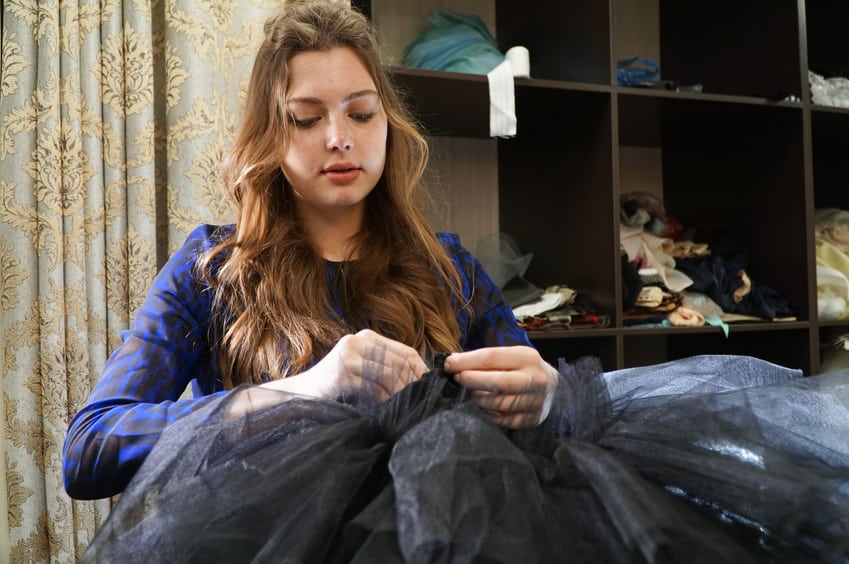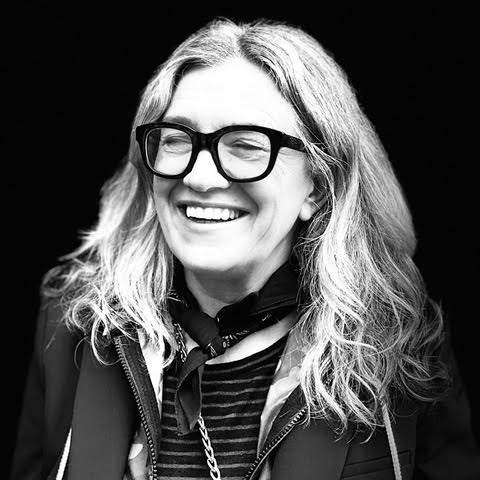Film Career Finder
Start Here:
Costume Designer
Career Overview
The Costume Designer creates the costumes that help to inform the characters and tell their stories in a film. They are the artistic head for all costume-based decisions on a shoot.
Alternate Titles
Head of Wardrobe
Salary Range
$3,000 to $3,500+ per week on a film

How To Become a Costume Designer
- Career Description
- Salary
- Career Outlook
- Career Path
- Experience & Skills
- Education & Training
- Additional Resources
- Sources
Career Description
The job of a Costume Designer is to define the character through costume. They are the leader of the costume department making sure the creative vision behind the costumes is consistent with the rest of the filmic elements, including production design and general storytelling. They direct the rest of the costume department and oversee its schedule and budget.
The Costume Designer comes aboard a project during the pre-production phase. This is when they will read the script and meet the Director to familiarize themselves with characters and story.
From there, the Costume Designer will research all elements relevant to costuming such as the time period and story location to create sketches or a mood board for the Director to review. After an aesthetic has been agreed upon, the Costume Designer will work with their team, Character Designer, and Set Dresser to build or shop for costumes.
When principal photography begins, the Costume Designer manages their team and makes sure that each costume is implemented in the way it was intended. This can include continuity, use in the correct scene, and dressing the Actors.
To learn more about working as a Costume Designer, we spoke with Susan Lyall (Being the Ricardos, Clifford the Big Red Dog, Luther).
Salary
The salary for Costume Designers working on a union film is around $3,000 to $3,500 a week. Costume Designers are generally considered freelance workers, which means that they do not receive benefits from gig to gig. However, if they are part of the Costume Designers Guild, they are guaranteed certain minimum rates and other advantages because of their inclusion in a union.
At the outset of their career, a Costume Designer may be working for very low or no pay at all as they build their portfolio. Given that they are freelancers, they can set their own rates, but they may be asked to negotiate them depending on the budget for a particular project.
As a Costume Designer builds their portfolio, skillsets, and experience, they will acquire greater leverage in terms of raising their rates.
“Costume Designers are really low on the totem pole of salary… even the Assistant Prop Person makes more than the Costume Designer’s scale,” explains Lyall. “It has a lot to do with it being a traditionally female position.”
Despite these pay discrepancies, seasoned Costume Designers can earn a substantial rate over time. “Realistically, after decades of experience, you would probably get up to $7,000 or $8,000 per week.”
Career Outlook
The position of Costume Designer on a film is an incredibly important one, as they carry the primary responsibility of conveying character through wardrobe choices. Given this leadership role, the professional life of a Costume Designer can be a highly rewarding yet demanding one.
For one, the hours can be long. Though the hours on a project will vary from film to film, a Costume Designer is expected to work whenever the production needs them. That means days, evenings, and weekends.
For instance, should a shoot be scheduled at night, the Costume Designer must be present to supervise wardrobe from dusk until dawn. The ever-changing and long hours can make the life of a Costume Designer anything but routine or conventional.
Sometimes a Costume Designer has an entire department to help them. Other times, they might be the only one in charge, especially when working on smaller projects early on in their career. “I have personally done that,” says Lyall. “It’s just me and I’m the fitter, I’m washing the clothes, I’m sewing on buttons, I’m talking to the Director and meeting with the Actor. It may seem crazy, but when you’re young it’s really fun. Definitely don’t be afraid to start small and have that experience.”
Putting in those long hours for little or no pay in the early stages of your career may necessitate taking on other kinds of jobs to maintain your quality of life.
Two, Costume Designers must be as skilled at communicating with a host of other creatives as they are designing and crafting the costumes the Actors will be wearing for a film.
A Costume Designer often has the opportunity to be part of a highly creative field and work with other talented professionals. The biggest artistic collaborator for a Costume Designer is the Director.
However, a central part of the job of a Costume Designer is maintaining collaborative and communicative relationships with those in their department during the life of a project. As such, their day-to-day contacts generally include the Assistant Costume Designer, Illustrator, Shoppers, Drapers, and any Production Assistants assigned to the department.
As an aspiring Costume Designer works their way up the career ladder, they may in fact be hired in any of these collaborative roles as they gain experience and grow their skillsets.
The Costume Designer also attends all meetings with key crew such as the Cinematographer, Key Hair, Key Makeup, Production Designer, Key Grip, and Gaffer to make sure that they’re all creating a unified aesthetic. They may also need to know technical details which fabrics could create issues for the Sound Recordist, or whether the lighting choices made by the Cinematographer might cause unusual shimmering or color effects on the clothing.
Career Path
As with so many other facets of the film industry, there is no single path to becoming a Costume Designer.
That being said, in many cases it starts with college. Given their interest in cinema, some aspiring Costume Designers may go to film school. But those looking to enter this field have no shortage of costume design programs from which to choose as well. In fact, according to Lyall, going to graduate school in costume design might make it much easier to join a union, even without significant assistant experience.
While in college, Costume Designers can begin to sharpen their craft by working on student films or local short films.
– Susan Lyall
Should they have an opportunity to work on a larger project, though, it will likely be as a Production Assistant with room for upward movement.
Understanding all the many elements that go into costume designing and becoming proficient in them can many take years to master, but according to Lyall, it’s possible to gain enough experience to join a union within two to three years. During that time, an aspiring Costume Designer must learn those practical skills by assisting others more established in the field and building a reputation that makes them in demand for future jobs.
Costume design is a highly collaborative craft, which makes it just as vital for aspiring Costume Designers to know the importance of making and sustaining strong professional relationships as to master those practical costuming skills.
Much of the movie business is relationships and referrals. To continue getting those opportunities to learn on the job and keep moving up towards roles with more responsibility, someone looking to become a Costume Designer must be comfortable working well with others and growing their professional network.
As mentioned, smaller projects might allow for greater responsibility early on in one’s career, which can help them get on bigger projects as well.
“If you send in your resume to a production and state that you’d like to work as a PA in the Costume Department, it will get passed to the Costume Department,” says Lyall. “If someone in the Costume Department sees that you’ve worked on two student films, that means you have a little bit of knowledge, and that can be enough. I’ve hired all kinds of PAs with all kinds of experience.”
Regardless of the scope of the project, aspiring Costume Designers can put themselves in the best position for career success by taking the following steps:
- Familiarizing themselves with costume history, particularly in film.
- Practicing basic costume construction along with basic sewing.
- Watching movies and figuring out why Costume Designers made particular choices.
- Reading scripts and building a portfolio for pitching to Directors and Producers.
Experience & Skills
A successful Costume Designer must possess a varied skillset.
Perhaps most obvious is a mastery of costume construction, but this skill goes well beyond being able to sew together a dress or suit.
A Costume Designer must have basic knowledge of fashion history and/or the ability to research different eras to ensure not only that is every character represented faithfully through their wardrobe but also that their wardrobe is consistent with the time period and location. What was worn in 1970s New York City, including fashion trends and clothing materials, is worlds away from what was worn in 1790s Paris.
A successful Costume Designer must also understand the relationship between costumes and character. Their job is to tell the audience who every character is through what they are wearing. That means having a keen understanding of and connection to each character’s psyche and how it translates to their attire.
These skills can be gained and deepened by taking on as many on-set opportunities as possible. It’s through these different production experiences that a Costume Designer can develop their creative sensibilities and grow their confidence in making choices that the Director and other high-level creatives like and appreciate.
Given the importance of working many different gigs to get that experience and strengthen those skillsets, aspiring Costume Designers should be prepared for long and sometimes erratic hours on the job.
Education & Training
While possible to learn on the job, the many costume design programs available demonstrate how popular it is to get a degree in this discipline.
It’s important to keep in mind that the education of a Costume Designer doesn’t stop. Throughout the course of their career, they should always be developing their costuming knowledge as it relates to era, locale, and character.
Whether or not an aspiring Costume Designer begins their career with film school or a specialized design program, it can help to find a mentor-mentee relationship where they can learn from someone already established in the costume design world. That is another reason why taking entry-level positions as an Intern or PA can be immensely helpful, as they offer the chance to meet high-level Costume Designers and potentially forge a relationship that could lead to a mentorship.
Aspiring Costume Designers can also look to the internet where sites like YouTube and Masterclass offers costume design instruction.
Additional Resources
Even if a Costume Designer is not yet eligible to join the Costume Designers Guild, also known as Local 892 in Los Angeles, they can learn about what the union has to offer Costume Designers, Assistant Costume Designers, and Illustrators. They might also be able to meet those in the union and attend or volunteer for union events.
Motion Picture Costumers, also known as Local 705 in Los Angeles, is the union for Stitchers, Drapers, Shoppers, and everyone between those classifications. Again, understanding these two organizations can show an aspiring Costume Designer how to advance in the industry.
As mentioned, according to Lyall, one of the greatest sources of inspiration for aspiring Costume Designers is the world itself. While it can be tempting to bury yourself in books and courses, she emphasizes the importance of staying open to real-world experiences. “Just be curious about the world,” she says. “You never know when it’s going to connect to something you’re going to design.”
